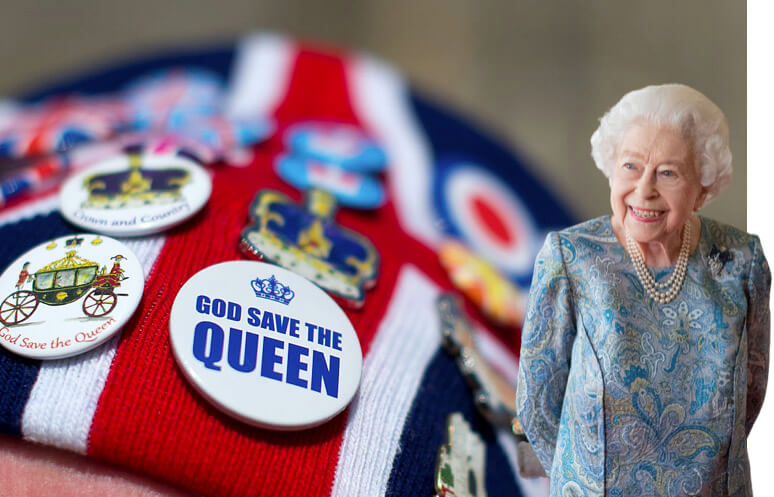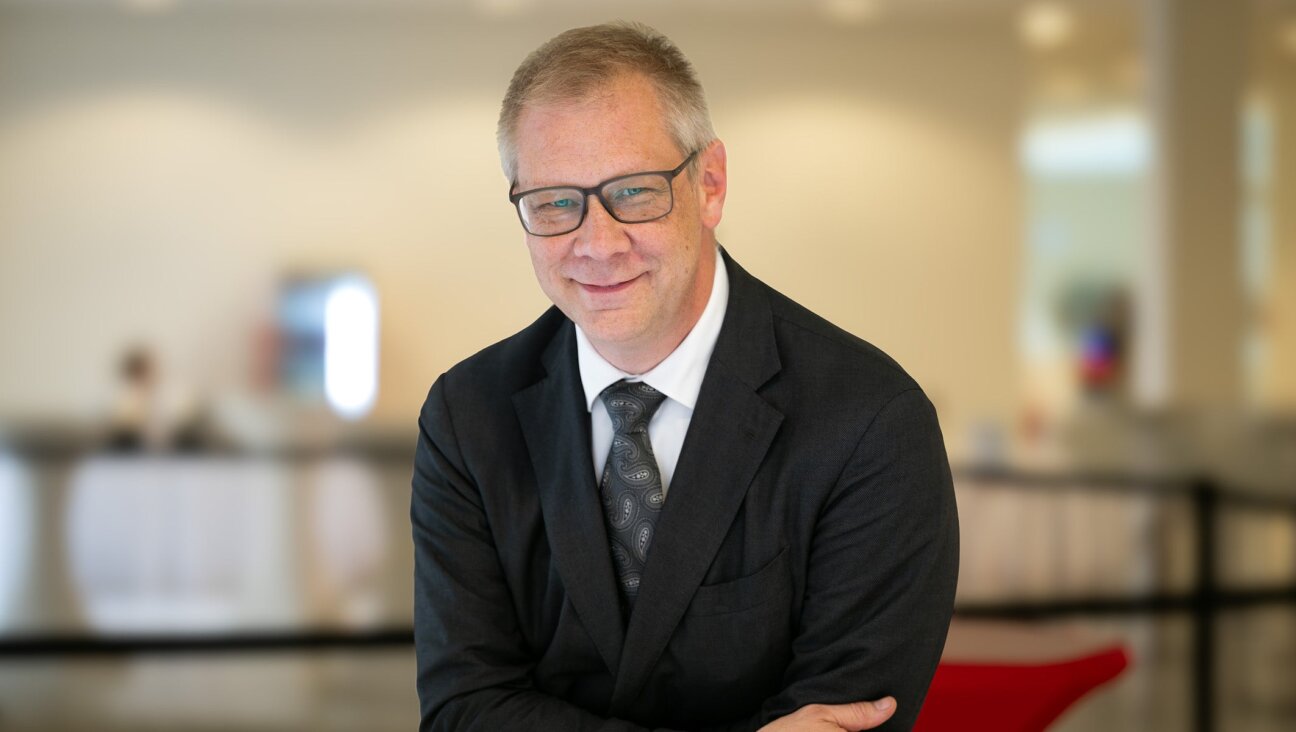How the queen’s death changes British Jewry’s most distinctive prayer
On the Shabbat after Queen Elizabeth’s death, British Jews and their counterparts in the Commonwealth changed one of the mainstays of their service. Where does the ‘Prayer for the Royal Family’ come from? And why is the prayer recited in English, not Hebrew?

The royal succession required a tweak to long-standing Jewish liturgy in British synagogues. Photo by Getty Images
This article originally appeared on Haaretz, and was reprinted here with permission. Sign up here to get Haaretz’s free Daily Brief newsletter delivered to your inbox.
At 6.30 P.M. last Thursday, the world was informed of Queen Elizabeth II’s death. Flags were lowered to half-mast, the Royal Artillery fired a 96-gun salute and a 10-day emergency protocol, called Operation London Bridge, began across the United Kingdom. Among all the pomp, British Jews began executing a modest plan of their own.
For starters, the royal succession required a tweak to long-standing Jewish liturgy in British synagogues because, every Shabbat for over 70 years, Jews across the United Kingdom would say a prayer in honor of Queen Elizabeth and the rest of her family. And as one of the few prayers recited in the English language in U.K. synagogues, the “Prayer for the Royal Family” is one of the best-known prayers to British Jews.
The Orthodox version begins: “He who gives salvation to kings and dominion to princes, whose kingdom is an everlasting kingdom – may He bless: Our sovereign lady, Queen Elizabeth, Charles, Prince of Wales, and all the royal family.”
Rabbi Dr. Jonathan Romain of Maidenhead Reform Synagogue, which is located just 6 miles (10 kilometers) west of the royal residence of Windsor Castle, explains that the prayer has its roots as far back as the exile from Jerusalem, when Babylonian Jews sent a letter back to the prophet Jeremiah asking how they should relate to their new rulers.
“Seek the peace of the city whither I have caused you to be carried away captive, and pray unto the Lord for it; for in the peace thereof shall ye have peace,” he advised them (Jeremiah 29:7).
One of the earliest examples of the prayer comes from Portuguese rabbi and kabbalist Menasseh ben Israel, who played an instrumental role in securing the readmission of Jews into England, and presented the prayer to Oliver Cromwell in 1655 in a bid to persuade him of the Jews’ “constant obedience to their Princes … For on every Sabbath or festival day, they every where are used to pray for the safety of all Kings, Princes and Common-wealths, under whose jurisdiction they live, of what protection-soever.”
Shortly after the Jews were readmitted to England following their 1290 expulsion, a 1663 entry from Britain’s most famous diarist, Samuel Pepys, detailed his visit to a Sephardi service at the Creechurch Lane Synagogue (today Bevis Marks Synagogue) in the City of London, and one of the first recorded writings on the recitation of the prayer: “In the end they had a prayer for King, which they pronounced his name in Portugall; but the prayer, like the rest, in Hebrew,” he wrote.
The newly-resettled community, however, was a historical outlier for the recitation in Hebrew. At least from the time of King George III’s reign, Romain explains, the prayer was said in English. Some versions save the monarch from “peril,” while others focus on “sorrow,” but the message remains fundamentally the same.
And just as French Jewry would recite their prayers for Napoleon in French, “the prayer is done in English so that any non-Jews would know you are loyal to the country,” Romain explains – before offering up his own royal anecdote about the prayer.
In 1990, the Queen’s younger sister, Princess Margaret, came to Maidenhead to mark the synagogue’s golden jubilee. After the service, she asked whether the prayer had been recited especially for her. Romain explained that every synagogue in the country recites the prayer on a weekly basis – prompting Margaret to say that even churches did not bestow them with such an honor, and promised to tell her sister.
The tradition also extends far beyond the British Isles, to countries in the Commonwealth (the majority of which are former territories of the British Empire). In 1911, for example, the Gate of Mercy Synagogue in Bombay (now Mumbai) issued a special prayer for King George V, while a synagogue in Calcutta (now Kolkata) called on God to “bless, guard, protect and help, exalt, magnify and highly aggrandize our Sovereign Lord, King-Emperor George V.”
The royal prayer can be heard in Australia, as well. Rabbi Ralph Genende says it was recited every Shabbat during his 14-year tenure at Caulfield Shule, Melbourne’s largest Orthodox synagogue. There is even a framed photo of the prayer – as is common in many synagogues – though in this case it flanks the Torah ark.
Romain, meanwhile, notes that his synagogue’s own royal plaque will now need to amend “Her Majesty the Queen” to “His Majesty the King.”
Special prayer
So what has British Jewry’s own Operation London Bridge looked like? Following Queen Elizabeth’s death, Chief Rabbi Ephraim Mirvis issued a special prayer in English and Hebrew to mark her passing, and said he would revise the royal prayer’s wording to reflect Charles’ ascent to the throne.
“She never let us down.” The Chief Rabbi responds to the passing of Her Majesty The Queen. pic.twitter.com/Y3zfw9VEdC
— Chief Rabbi Mirvis (@chiefrabbi) September 8, 2022
Rabbi Jonathan Wittenberg, senior rabbi of the 13-synagogue strong Masorti Judaism UK, says his movement has an alternative “prayer for the state,” which simply requires the changing of “Queen” to “King.”
When the news broke last week, Wittenberg recounts that he took the “memorial prayer for King George and adapted it appropriately.” He has also invited members of his own synagogue to prepare tributes to Queen Elizabeth this Shabbat.
Meanwhile, the Movement for Reform Judaism, comprising 42 synagogues in the United Kingdom, says it “issued all of our synagogues with an updated version of our prayer for the Royal family. [In the] British faith community, we acknowledge the freedom and protection afforded us to practice our Judaism.”
As for revising the siddur (prayer book) to reflect the new monarch, a “new prayer page is set up to simply stick over the old one.”
The rabbis with whom Haaretz spoke testified to a surprising amount of emotion during the royal prayer last Shabbat, with Romain noting that his synagogue even sang the national anthem – now altered, of course, to “God Save the King.”
In a condolence notice, Michael Goldstein, president of the United Synagogue (the largest synagogue body in Europe), stated: “For 70 years, the Queen has been a constant for generations of United Synagogue members, the wider Jewish community and the nation at large. Across the country, every week, without exception, we say the ‘Prayer for the Royal Family’ in our shuls.
“Since 1952, when Her Majesty the Queen ascended to the throne, there have been more than a dozen versions of the ‘Prayer for the Royal Family’ to reflect changes to the royal family: marriages and, sadly, deaths. The one constant in the prayer throughout the last 70 years has been ‘Our Sovereign Lady, Queen Elizabeth,’” he continued.
“With a heavy heart, we shall now be issuing a new prayer to our communities as we join together to pray that God blesses our new king and puts a spirit and wisdom into his heart and into the heart of all of his counsellors,” he concluded.
And for anyone attending a United Synagogue service in Britain this weekend, the modified royal prayer will now ask for blessings upon “our Sovereign Lord, King Charles, our gracious Queen Consort Camilla, the Prince and Princess of Wales, and all the royal family.”












